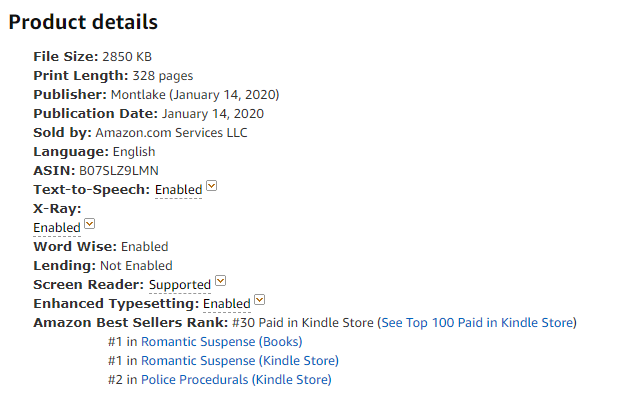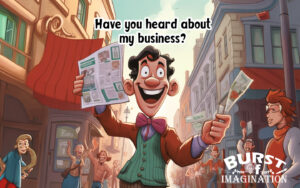How Do I Conduct Market Research For My Book?
Kevin Hernandez May 13, 2020You might have heard the phrase success leaves clues. Market research is our way of discovering those clues so we can incorporate them into our own works. It is not just about finding out what works, but identifying what we can do better than other books in the market place.

Market Research is the key to unlocking what your customers actually want.
You spend months writing that perfect book. You love it. You publish it and make it available to the world and…crickets. No one is buying it.
This is one of the leading fears for self-published authors. We want to make additional income or we might have already had a hit and we can’t understand why our latest project isn’t selling as well as the first one.
Here is where market research comes into play. There are already established hits that are killing it in the marketplace. Why are they doing so well? It’s because they have already tuned in to what the market wants.
The goal isn’t about stealing someone else’s work. It’s about learning what our customers actually want and then giving it to them using our own voice.
You might have heard the phrase success leaves clues. Market research is our way of discovering those clues so we can incorporate them into our own works. It is not just about finding out what works, but identifying what we can do better than other books in the market place.
Here is How We Conduct Market Research
- Identify Bestselling Titles in your Niche.
- Review their Book Covers.
- Review their Book Titles.
- Study the Book Descriptions.
- Read the Book Reviews.
- Research Author Websites.
1. Identify Bestselling Titles in Your Niche
We are going to start a search on Amazon.com. Amazon is the largest bookseller in the world. They have made it very easy to review the best sellers in each category. The reason we want to target the best sellers is that these are the books that readers have voted on as the best books. Consumers vote with their wallets. Anytime someone makes a purchase they have told us that this is what our market prefers.
How to Conduct Niche Research
Before you can identify the bestsellers in your niche, you must know what niche you are in or want to be in. If you have already done this step feel free to skip this portion.
The goal of conducting niche research is to confirm the book niche or sub-category we are in is actually a profitable one. Or at the very least one that people are interested in searching for. Niche research is a fundamental skill in book publishing. The Kindle Store bestseller lists at amazon.com can be your best friend when it comes to doing this type of research.
You will want to dig deep into sub-categories and identify 3-4 themes within a niche that you’ll include in your book. This will help make sure your book actually sells. It will let you identify what is trending and what readers currently want to read. This will also be used when publishing your book’s keywords.
When you clarify what your niche is then people will understand your brand better. Your pen name or brand will thrive off of the audience you establish here. Solidifying your niche gives your audience a way to understand who you are and the type of books they can expect from you.
You build an audience by delivering similar content to what your readers already like. Think about it this way, your specific niche equals the specific audience you’re serving.
To get started with your research you’ll want to go to Amazon.com. You don’t want to be signed in to your Amazon account when doing this research. We don’t want recommendations based on our purchase history. We want Amazon to give suggestions and help us based on their general recommendations. Sometimes it helps to even us a different browser than you normally do so cookies and search history don’t create bias.
Navigating to the Kindle Store’s Best Sellers
- After ensuring you aren’t signed into your Amazon account, go to the Kindle Store.
- Then go to the bestsellers and more section.
- Select Kindle Best Sellers. This should show you the top 100. Most of the best sellers will be fiction.
- Next, select kindle ebooks and it should now display the different sub-categories available.
Let’s say you were researching Romance books. You would click on the Romance category. Go ahead and open up the number one book.
If you scroll down to the very bottom of the book details screen, you can see some very helpful details about the book. The section we want to find is the product details section. Here is an example of the product details section:

This section will tell you the paid ranking, who the publisher is, how long the book is, and more. In the screenshot example, we see that this book is the #30 paid book in the Kindle Store. This information is located at the bottom of this portion in the Amazon Best Sellers Rank field. We also see some of the categories it ranks in # 1 Romantic Suspense and #2 Police procedurals.
Once you have the paid rank you can go to kindlepreneur.com and go to their free KDP calculator. The calculator will give you an estimate of how many books someone is selling per day to get that ranking.
They have a free tools link on their homepage that will help you locate the KDP calculator if you’re having trouble finding it. Once you find the free calculator tool, simply enter the paid rank into the search box and you will receive the estimated number of books sold per day.
If the book is a kindle unlimited title, then you can look at the page count of the book which is also found in the product details section to gauge how much the author is making per book.
Kindle Unlimited
The kindle unlimited program is kind of like Netflix for books. Customers pay a monthly fee and can check out books from the kindle unlimited library. Authors get paid by page views.
They currently get half a cent per page view. If the reader reads the entire book, then that’s $1.50 for a 300-page book. Just take the page count and divide it by two. That’s roughly the amount of cents the author could get for the book.
There are a couple of factors that will affect the actual payment including how many pages the reader actually reads and the differences in a kindle book page sizes versus non-kindle page count.
Typically, the kindle book will have more pages than is listed in the count. And Amazon might not count any of the forwards or thank you pages found in the book.
The amount an author is making can tell you if it’s a profitable niche to get into. The number of books sold in each ranking can tell you if it’s something you can compete with.
Take the number 1 best selling book in the niche or sub-category you are researching and then do the same with the number 100 book in that same category. Your goal should be to rank within the top 100 of whichever category you choose.
Using the KPD calculator will help you see the target for books sold per day. Knowing how many books you need to sell to reach within the coveted top 100 will help you know how difficult it might be when you are first starting off.

2. Review Their Book Covers
The purpose of this section is to identify trending themes in the top 100 books for your niche. This can give you ideas that you can turn around and incorporate into your own books.
I would recommend having a notebook or note-taking app handy and taking note of everything that stands out to you. What common themes are you finding? Which ones feel like they would go well with the type of book you want to make.
Does a quarter of the top 100 have a man with long hair holding a woman? Do they feature a specific season or setting? Do any of them look like books you would like to read, and why?
These details can help you when working on your own covers. There might even be examples you can share with your illustrator to help them envision what you want. Obviously, we are looking at Romance examples, but this would apply to whatever niche you are targeting.
Make certain that your cover actually looks like it belongs in your category. Books on business or finance will often have images of money. Pay attention to elements often used in your genre.
You don’t want to make the mistake of looking like your book is in the wrong section.
The other elements that are helpful to review include the font used, colors on the page, images, and even the emotion that the cover evokes. These are all elements of book covers that you should take note of.
When you are taking note of these elements also consider their placement. Where in the image is the title going? Where are they placing the subtitle and author name?
3. Review Their Book Titles
When conducting market research for your book, it’s important to pay attention to the titles you are seeing. A common theme might jump out and it could help you when naming your own book or even when writing your book.
A trending theme could be just what you need to grab new readers. An example in Romance is the accidental angle. We saw books like the accidental husband, the accidental marriage, or the accidental protector. Is that an element you want to consider?
A popular sub-category of Romance is Regency Romance. When looking at the top 100 titles many of them stated the position of the romance interest. For example, Earl, Laird, Lord, and Duke were often used in the title itself.
Another theme that kept coming up was the title of highlander, which lets us believe it will have ties to Scotland and muscular men in kilts.
What common trigger words are you seeing?
Pay attention to the language used to attract potential readers. Are they aiming for certain emotions? We also want to take note of any subtitles used. There might be elements that stand out.
Consider the customer’s journey to discovering your book. They will more than likely start by doing a search on Amazon or Google. This makes the keywords used to find your book very important.
Outside of researching the best sellers, you can also go to the Amazon search feature and type in your genre to see if it starts auto-completing your search results. These recommendations that Amazon is providing can potentially contain keywords that Amazon is indicating already has search volume.
We use a method called alphabet soup to help us identify keywords to use. Type in your theme or category and then the letter a. Take note of what comes recommended from Amazon. Then do that again with the letter b. You can do this until you have identified some keywords that are associated with your niche and that make sense with your book.
This is also why we didn’t want you to sign in under your Amazon account earlier. Otherwise, the search recommendations will just be targeted to your own preferences. Now let’s dive into book descriptions.
4. Study the Book Descriptions
Reading popular book descriptions in your niche can help you gain an idea of what has worked well in your genre. Many aren’t just a synopsis of the book but often feel like reading a chapter from the book itself.
You want to look at any keywords or phrases used. This is also an opportunity to spy key concepts that are becoming popular. What is jumping out at you as you’re reading these book descriptions?
This is another opportunity to identify any themes you want to incorporate into your book. Are there any angles you found amongst the top-selling books that might work well in your book?
Ideally, you will want to incorporate what you have found that is working well into your own book and your book’s description. You might even have noticed elements that you might want to avoid as you write the draft description.
A common practice among top authors is to actually write your book description before you write your actual book. Your book description needs to be less than 700 words and must include enough information for readers to want to buy your book.
If you struggle to clearly summarize your book in an appealing description, then you might actually need to spend more time discovering your audience and what makes this book different from all the others.
5. Read the Book Reviews

Take time to read a good majority of book reviews for books that are comparable to your own. This is an excellent opportunity to find out what your audience likes about books in your genre. And don’t neglect the negative reviews. These will tell you what your audience doesn’t like which can be just as important.
This is a vital step in conducting market research for your book. If you avoid this step then you are more likely to make the same old mistakes others have already made, and your book sales will suffer.
Think of every review you read as free data to help you understand your ideal readers even better. This should encourage you to read as many reviews as possible.
If you conduct sloppy market research, you’ll potentially miss out on vital information that could make a significant difference in your future sales.
Look out for patterns regarding what people like and don’t like. The more reviews you read, the more apparent these patterns will become to you.
If a single reader out of thousands mentions an issue, it could just be a personal preference. However, if dozens of readers bring up the same complaint or issue, you know there’s an important point to take note of. Observe any key themes the reviews are bringing up.
Readers ultimately determine if you will make it as a successful author. Pay close attention to what they say about your books and the work of other authors. Or you run the risk of the market ignoring you when your book launches. Knowing what your audience really wants allows you to tell your story based on what will serve your market best.
Smart book authors will even make rewrites or edits to their book after conducting their market research. Another advantage of reading as many reviews as you can get your hands on is that it can help you identify gaps in the marketplace.
This can position you to stand out in the marketplace. You can deliver a unique message that takes advantage of market demand and increases the likelihood of your book being purchased.
Look at this market research as a chance to see through the eyes of your readers. When you understand what readers want and need, then you have a competitive advantage over authors who neglect this research.
6. Research Author Websites

Another place that shouldn’t be overlooked in your market research are author websites. Using the bestseller list go look at the websites for these authors. Are they doing anything that stands out on their website that is allowing them to attract more readers?
Some authors have websites that they clearly don’t maintain at all. If that’s the case, you won’t learn much from looking at their site since it’s clearly not actively engaging readers. Part of our research is to determine if an author’s website is contributing to their success.
If you uncover an author with a super active site with lots of engagement and traffic, then you should study their top pages. What kind of blog posts do they have? What information are they posting that seems to resonate most with their audience.
An important part of building your audience is capturing reader emails with some sort of lead magnet. You might consider signing up for popular author’s mailing lists to see what they are offering in exchange for your email. Are they giving a free book? Is there maybe a free sample of their writings? This could be something you consider doing yourself.
Getting to know what their audience likes is exactly how to find out what your audience will like. As with any form of market research, you should model what works and stop doing what clearly isn’t working.
Let us know in the comments what you found most helpful. Also check out our marketing for creatives blog.


